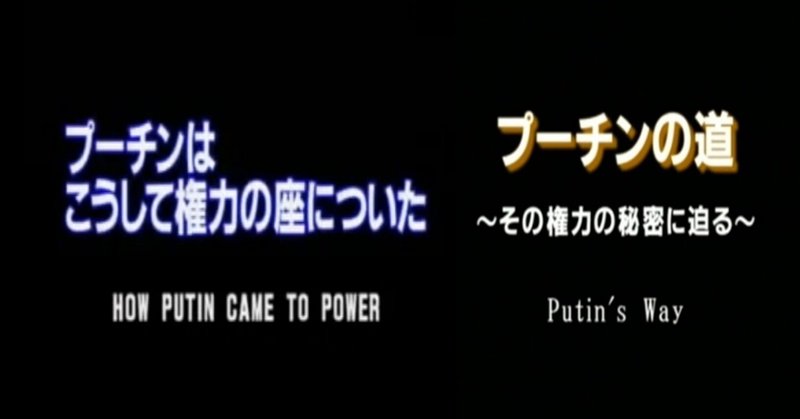
プーチンはこうして権力の座についた(2005年)・プーチンの道(2015年)『当初はコントロール可能な、ある種の民主主義モデルの構築を目指していました。それが上手く行かなかったので、先ずは穏やかな全体主義へとスライドし、徐々に厳しい全体主義へと移行しました。』(ミハイル・ホドルコフスキー)

大統領就任までの経緯と就任後の顛末を取材したドキュメンタリー番組

読者や視聴者の興味は移ろいやすく、たいていの事件や事故の報道は長続きしませんが、『お父さんのためのワイドショー講座』(TBSの報道情報番組「情報7daysニュースキャスター」の前身であった「情熱ワイド!ブロードキャスター」(土曜・午後10時~)の名物コーナー)が続いていれば、旧統一教会に関する話題か、ロシアによるウクライナ侵攻(ウクライナとロシアの戦争)に関する話題が、昨年(2022年)の年間ベストテン第1位に輝いたに違いありません。
但し、1950年代末に日本へ進出して以来ずっと(文鮮明教祖の没後、韓鶴子総裁の神格化が進んだこと等を除けば)主義主張や行動様式が首尾一貫している旧統一教会とは異なり、プーチン大統領の主義主張や行動様式は変遷してきたようです。
プーチン氏が大統領に就任するまでの経緯については、2005年にフランスで制作されたドキュメンタリー番組『プーチンはこうして権力の座についた』の中で詳しく解説されていますが、昨日移動中に長々と待ち時間が生じた際、2015年にアメリカで放送されたドキュメンタリー番組『プーチンの道』を久しぶりに視聴しました。
BS世界のドキュメンタリー
プーチンの道 ~その権力の秘密に迫る~
2016年12月6日(火)午後11時00分~
ロシアの絶対的な権力者、プーチン大統領は、いかにして現在の地位を手に入れたのか。数多くの黒い疑惑に包まれながら、独裁的な色彩を強めるプーチンの実像に迫る。
KGBの工作員として旧東ドイツに派遣された後、故郷・サンクトペテルブルクで政治家に転身したプーチンは、無名のままエリツィン政権下で首相となる。“テロと戦う”という名目で始めたチェチェン戦争で名を上げ、大統領となったプーチンは、財閥の囲い込みやメディアの統制などの手法で絶大な権力と財産を短期間で築き上げ、国際政治の舞台でも存在感を増していく。貧しい家に生まれた少年がクレムリンの主となるまでの道のりとは。
原題 Putin’s Way
制作 WGBH(アメリカ、2015年)
初回放送 2016年12月6日(火)午後11時00分~
再放送 2016年12月21日(水)午後5時00分~
2017年1月1日(日)午前2時00分~
2017年4月28日(金)午前0時30分~
2017年11月28日(火)午前0時00分~
2018年3月23日(金)午後5時00分~
https://www.dailymotion.com/video/x5jwvkz
Putin's Way
JANUARY 13, 2015 | RATING: NR | LENGTH: 00:53:41
https://www.dailymotion.com/video/x89exdj
1時間枠の番組ですが、元KGBスパイがあっという間に大統領への階段を駆け上がり、20年以上に渡ってロシアに君臨している経緯が簡潔にまとめられています。
番組の中でインタビューを受けた、かつては新興財閥(オリガルヒ)の雄であった、ミハイル・ホドルコフスキー氏(逮捕・収監(10年間)・恩赦を経て、国外で亡命生活中)の次の発言はとても腑に落ちます。
当初プーチンはコントロール可能な、ある種の民主主義モデルの構築を目指していました。
しかし、それが上手く行かなかったので、先ずは穏やかな全体主義へとスライドし、徐々に厳しい全体主義へと移行しました。
今後さらに状況が進むと、完全な全体主義のモデルが出来上がるでしょう。
はっきり言えば、全ての全体主義体制は泥棒政治と言っていいと思います。
At first, he thought he could build sort of a democratic model that he could control. A model like this does not exist, so he started to slide towards at first mild totalitarianism, and then an increasingly harsh totalitarianism. If the situation develops further, he will reach a full totalitarian model. In reality, every authoritarian system is a kleptocracy.
首相に就任する前にFSB(連邦保安庁)長官も務めたプーチン大統領は、元KGBスパイなので、端から世界中を騙していた(欧米と協調するふりをしていた)可能性はありますが、最初はそれほど悪い奴ではなかったのかもしれません。
尚、先ほどもふれましたが、プーチン氏が大統領に就任するまでの経緯については、2005年にフランスで制作されたドキュメンタリー番組『プーチンはこうして権力の座についた』の中でより詳しく解説されています。
また、お時間があれば、今世紀初頭(9.11 アメリカ同時多発テロ事件が発生した翌年)にNHKが制作したドキュメンタリー番組『ドキュメント ロシア(前編・後編)』も併せてご覧ください。
BS世界のドキュメンタリー
プーチンはこうして権力の座についた
2008年2月25日(月)午後9時10分~
事の発端は、クレムリンの改修工事に伴う大掛かりな収賄事件だった。エリツィン大統領と娘たちが、スイスの建築会社から自由に使えるクレジットカードを渡されたという疑惑をはじめ、ロシア高官たちのマネーロンダリングが取り沙汰された。検事総長のスクラートフが事件を厳しく追求していたが、当時FSB(連邦保安局・KGBの後継機関)長官だったプーチンは、スクラートフが売春婦と興じる盗撮ビデオを公にして、彼を失脚させることに成功した。
プリマコフ首相によるエリツィン追い落とし工作も未然に防いだプーチンは、1999年8月、エリツインから首相に任命される。就任直後、ロシア各地で起きたアパート爆破事件への報復措置として、素早くチェチェンへの軍事攻撃を開始したことが、ロシア人の愛国心を揺さぶった。エリツィンと近しい新興財閥のベレゾフスキーが、自らの所有するロシア公共テレビの人気コメンテーターであるドレンコを動員し、キャンペーンを行ったことなども効を奏し、国民の間でのプーチンの支持率が高まっていった。
クレムリンでの権力闘争の申し子とも言えるプーチン大統領の実像に迫る。
原題 How Putin Came to Power / La prise du pouvoir par Vladimir Poutine
制作 Quark Productions(フランス 2005年)
初回放送 2008年2月25日(月)午後9時10分~
再放送 2008年3月 3日(月)午前10時10分~
(日本語版)
(英語版)
(仏語版)
ドキュメント ロシア 前編 プーチン 権力への階段
2002年7月6日(土) 午後9時00分~
NHKモスクワ支局に保管されている連邦崩壊以来のロシアを記録した厖大な映像。それらをひも解くと、現在のロシアのビヘイビァが鮮やかに浮かび上がる。プーチンのKGB時代から大統領までの筋道をたどり、クレムリンの暗闘にせまる。
https://www.dailymotion.com/video/x8ak9dc
ドキュメント ロシア 後編 プーチン 苦渋の決断
2002年7月7日(日) 午後9時00分~
アメリカで起きた同時多発テロは、米ロ関係を大転換させた。チェチェン問題を抱え、巨額の軍事費と経済の立て直しに苦慮するプーチン大統領は、ブッシュ大統領の攻勢の前に苦渋の決断をしていく。テロをめぐる米ロの政治的攻防を描く。
https://www.dailymotion.com/video/x8akd3p
写真で振り返る . . . 欧米と協調(するふりを)していた頃のプーチン大統領



At the start of the 21st century we live in a new, closely interrelated world, in which unprecedented new threats and challenges demand increasingly united responses. Consequently, we, the member states of the North Atlantic
Treaty Organization and the Russian Federation are today opening a new page in our relations, aimed at enhancing our ability to work together in areas of common interest and to stand together against common threats and
risks to our security.”
Rome Summit Declaration, 28 May 2002
Introduction by NATO Secretary General
A new chapter in NATO-Russia relations was opened on 28 May 2002, when the heads of state and government of NATO member countries and of Russia gathered at Pratica di Mare Air Force Base, near Rome. A declaration on "NATO-Russia Relations: A New Quality" was signed, establishing a new NATO-Russia Council, which brings together the 19 Allies and Russia to identify and pursue opportunities for joint action "at 20".
The new Council provides a mechanism for consultation, consensus-building, cooperation, joint decision, and joint action. NATO's member states and Russia will work as equal partners on the basis of consensus on a wide range of Euro-Atlantic security issues. Continuous political dialogue will allow emerging problems to be identified early, common approaches to be determined or joint actions to be conducted, as required.
The Rome Declaration builds on the 1997 "Founding Act on Mutual Relations, Cooperation and Security", which remains the basic text governing relations between NATO and Russia. The ambitions expressed in the Founding Act were, however, never fully realised. In spite of the joint commitment to peacekeeping in the Balkans and the development of a substantial programme of practical security and defence-related cooperation, underlying inhibitions remained on both sides. The earlier Permanent Joint Council essentially remained a consultative forum with NATO member countries coordinating all positions before meeting the Russians in the "19+1" format.
What was lacking from the earlier NATO-Russia dialogue was a true sense of shared purpose and urgency. The events of 11 September provided that impetus – a stark reminder of the need for comprehensive and coordinated action to respond to common threats.
While the struggle against terrorism is now at the heart of our cooperation, we have a much wider shared agenda. Many of today’s security challenges can only be met cooperatively. We are determined to go beyond consultation and to work constructively together on all issues where we have what Russian President Vladimir Putin calls "the logic of common interest".
The real difference between "19+1" and "20" is not a question of mathematics, but one of chemistry: the success of the NATO-Russia Council will depend on the political will of the participants. This has been evident at all levels in meetings held since the summit to transform the political message of Rome into practical cooperation and to grapple with the rules and procedures of the new structure, so that the prospects for a genuinely new quality in NATO-Russia relations appear bright.
This publication was prepared to mark the significance of the Rome Summit. It is a compilation of the speeches delivered and the text of the Rome Declaration itself. I hope you will find it interesting and memorable reading.
Lord Robertson of Port Ellen


White House photo by Eric Draper







at G20 summit in Osaka.

Brendan Smialowski / AFP via Getty Images

Ian Langsdon / Pool via REUTERS
この記事が気に入ったらサポートをしてみませんか?
